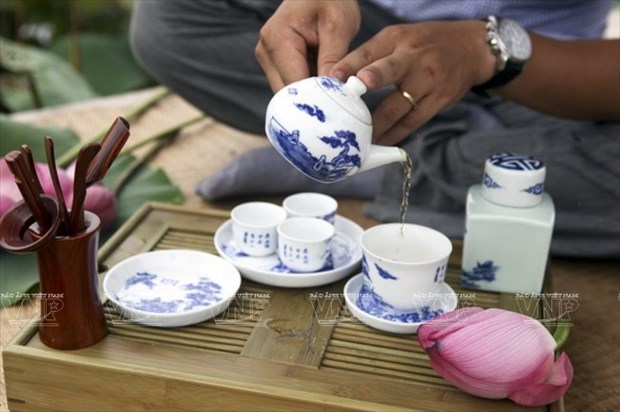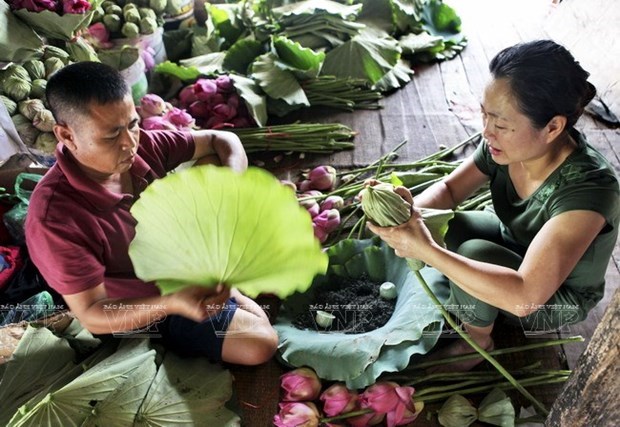Quintessence of Vietnamese tea art
 Enjoying tea is an elegant pastime of Hanoians (Photo: VNA)
Enjoying tea is an elegant pastime of Hanoians (Photo: VNA)Hanoi, (VNA) – Vietnam’s traditional tea art is neither sophisticated like the Japanese tea art nor complicated like the Chinese one. It is simple but elegant.
A cup of tea is always a good way to start a conversation, and a good pot of tea provides a wonderful time to strengthen family bonds or friendship.
In particular, brewing a hot pot of tea and sipping the drink during the rarely-found leisure time in the New Year holiday gives the feeling of peace and harmony with nature, dissolving any hassle of the daily life.
There are many types of tea in Vietnam, and Tay Ho lotus tea is no doubt one of the most famous. It is a specialty of Hanoi, as the tea is made only with lotus flower grown in the city’s Ho Tay (West Lake).
 People in villages around the West Lake make the famous Tay Ho lotus tea (Photo: VNA)
People in villages around the West Lake make the famous Tay Ho lotus tea (Photo: VNA)It requires a complicated and time-consuming process to make Tay Ho lotus tea the traditional way. The best tea used to make Tay Ho lotus tea should be from the Shan Tuyet tea trees which only grow at an altitude of 800-1,300m on mountains in the northern region, or from the Thai Nguyen Highlands. Sweet and not too acrid, these teas complement the lotus fragrance, according to tea artisans in Hanoi.
The selection of lotus also requires great care. While lotus flowers are easy to grow and can be found anywhere, the lotus blooms in Ho Tay have a distinctive fragrance. This kind of lotus is also known as the "lotus of a hundred leaves".
On West Lake, the lotus bloom for just three months, between the fourth and the seventh months of the lunar calendar. This is the hard season for tea makers.
The lotus used to make the tea must be collected in the early morning, when the dew remains heavy, in order to ensure the tea's freshness. After being picked, the anther (the part of the stamen that carries pollen) is quickly separated from the flower before it withers and loses its fragrance.
Then the anther is mixed with high grade dried green tea. For every layer of tea, a layer of fresh lotus anthers must be laid down.
The mix is then stored in a closed environment for two days to allow the lotus fragrance to infuse into the dried tea leaves. After two days, the lotus anthers are removed from the tea and replaced with fresh ones. This process is repeated seven or eight times over a span of three weeks or more. After this, the famous Tay Ho Tea becomes ready for the market.
It takes 1.5 to 1.7 kilograms of lotus anthers, or 1,500 lotus flowers, to make just one kilogram of tea. Each batch yields only five to seven kilograms of the finished product.
The last step is to brew a pot of lotus tea for enjoyment.
Besides lotus tea, there are various types of tea flavoured with different flowers such as chrysanthemum, or jasmine. And of course plain green tea remains the most popular. With the country’s international integration process, many kinds of foreign tea have been introduced into Vietnam. Besides, the health conscious trend gives rise to the popularity of herbal tea.
Few people have time to sit down for a cup of tea in the traditional ritual style. But most can still enjoy tea everyday. One can easily see people sitting on small stools on the street pavement, sipping a cup of tea.
And on the occasion of the New Year festival, a cup of tea is indispensable when a visitor arrives in the house. Sipping tea, host and guest exchange wishes for a happy new year with new success. The tradition has become part of the Vietnamese spirit./.










